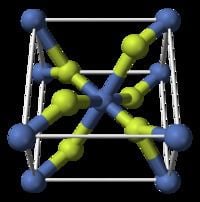Formula NiF2 Melting point 1,474 °C Boiling point 1,750 °C | Molar mass 96.6902 g/mol Density 4.72 g/cm³ | |
 | ||
Appearance Yellowish to green tetragonal crystals | ||
Nickel(II) fluoride is the chemical compound with the formula NiF2. Its is an ionic compound of nickel and fluorine and forms yellowish to green tetragonal crystals. Unlike many fluorides, NiF2 is stable in air.
Contents
NiF2 comprises the passivating surface that forms on nickel alloys (e.g. monel) in the presence of hydrogen fluoride or elemental fluorine, which is why nickel and its alloys are among the few materials that can be used to store or transport these fluorine compounds. NF2 is also used as a catalyst for the synthesis of chlorine pentafluoride.
Preparation
NiF2 is prepared by treatment of anhydrous nickel(II) chloride with fluorine at 350 °C:
NiCl2 + F2 → NiF2 + Cl2The corresponding reaction of cobalt(II) chloride results in oxidation of the cobalt, whereas nickel remains in the +2 oxidation state after fluorination because its +3 oxidation state is less stable. Chloride is more easily oxidized than nickel(II). This is a typical halogen displacement reaction, where a halogen plus a less active halide makes the less active halogen and the more active halide.
Nickel(II) fluoride is also produced when fluorine reacts with nickel metal.
Reactions
A melt of NiF2 and KF reacts to give the green compound K2[NiF4]. The structure of this material is closely related to some superconducting oxide materials.
Nickel(II) fluoride reacts with strong bases to make nickel(II) hydroxide, a green colored compound.
NiF2 + 2 NaOH → Ni(OH)2 + 2 NaF
